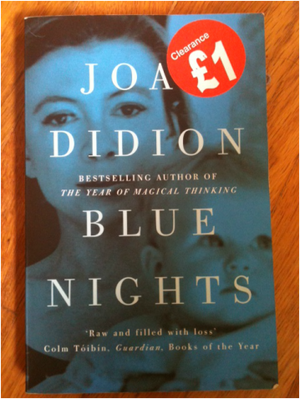 Three years after its release, a dear friend purchased this book for me after spying it on the £1 table in a basement bookshop in Edinburgh presumably because he knew how much I worship Joan Didion. (I had recently posted a b&w photo of her looking forlorn and smoking in front of her Corvette in the 1970s.) I started the book on the plane home to California—she’s so iconically American, I couldn’t bear to read it in the UK for fear that she might seem how I felt…out of place. Didion opens this follow-up to her previous memoir, The Year of Magical Thinking, which chronicled the year following her husband’s death, by describing a particular color of sky. It’s that magical time at dusk when the blue begins to deepen before turning to black—a slow fade from azure to indigo—that has always brought a sense of the night’s possibility along with a hint of reckoning. Apropos perhaps given that Blue Nights is laced with Didion’s recollections about raising her daughter, and treads lightly around the subject of her daughter’s untimely death at 39. As a writer who usually deals with difficult subject matter cleanly, Didion seems to have written this in a fugue. In this subject, she may have met her match, as the book never satisfactorily resolves the obvious questions about the circumstances of her daughter’s death—how a seemingly healthy, recently married woman becomes ill and dies, just like that, without explanation? And how does a consummate journalist like Didion ignore this fact? As other reviewers have pointed out, namely Jennifer Matesa in The Fix, Didion seems unable or unwilling to root out what may have been the cause of her daughter’s death, gently skirting a substance abuse problem, while Meghan O’Rourke in Slate, suggests it is a lack of grieving but regret that clouds her frame. These reviewers may be too harsh, as the book needs to be viewed in context of the author's whole body of work. Given that Blue Nights has been out for years, it’s hardly worth commenting on now. Yet somehow it is. This book will be read and remembered as Didion’s most vulnerable work. It meanders through a sacred subject, motherhood, and specifically, the unmapped path of a mother’s love and a daughter’s death. Within the pages of Blue Nights, you can see that this nearly undoes her as a writer. She reveals that the rhythm of her writing is off. She calls it a “directness” that characterizes her writing now. Writing is, as it always has been for Didion, a matter of style. But here she is off her game, unable to pull off what has always worked—her craft. Grief will do this, as will shame or regret. She gives us access to her rawness, and at the same time carefully guards her daughter’s privacy. Mothers share an impulse to protect our children even when we can’t, even when we can no longer do so, in death. Maternal love is a lot like unrequited love. We love and we know not what will become of them. And if the unthinkable happens, yes, it is an event from which we do not return the same. Through first The Year of Magical Thinking and then Blue Nights, we’ve watched as this writer took two fatal blows to the chest, though the first one just slowed her down. In this way, Blue Nights reads more like a love poem to her daughter, and to the life they once shared, which, at 77, seems to be the author's prerogative. She is Gibbons' Silver Swan—and brave to let us see her slowly coming undone. In this final farewell, to her family, her fans, the life she knew and her long and accomplished career, she’s earned the right to play it as it lays. Buy books at an independent bookseller to keep your community strong. Care to share how you buy books...a survey.
0 Comments
|
About this BlogWritten by Hannah Onstad, unless specified otherwise. Occasionally, posts here have been previously published elsewhere, and if so, that is noted at the top. Archives
June 2020
Categories |
